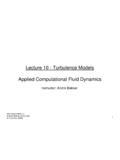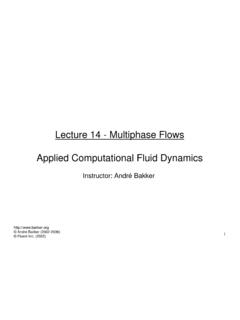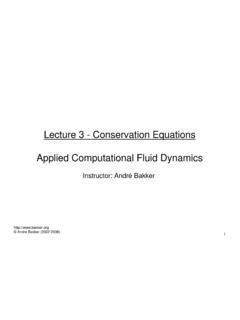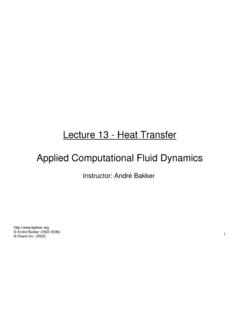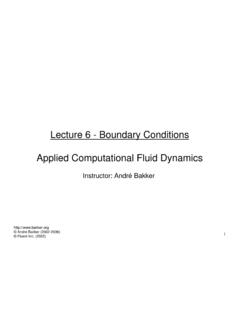Transcription of Lecture 11 – Boundary Layers and Separation …
1 1 Lecture 11 Boundary Layers and SeparationApplied Computational Fluid DynamicsInstructor: Andr Andr Bakker (2002-2006) Fluent Inc. (2002)2 Overview Drag. The Boundary -layer concept. Laminar Boundary - Layers . Turbulent Boundary - Layers . Flow The surrounding fluid exerts pressure forces and viscous forces on an object. The components of the resultant force acting on the object immersed in the fluid are the drag force and the lift force. The drag force acts in the direction of the motion of the fluid relative to the object. The lift force acts normal to the flow direction. Both are influenced by the size and shape of the object and the Reynolds number of the < 0Up > 0U wThe drag force4 Drag prediction The drag force is due to the pressure and shear forces acting onthe surface of the object. The tangential shear stresses acting on the object produce friction drag (or viscous drag).
2 Friction drag is dominant in flow past a flat plate and is given by the surface shear stress times the area: Pressure or form drag results from variations in the the normal pressure around the object: In order to predict the drag on an object correctly, we need to correctly predict the pressure field and the surface shear stress. This, in turn, requires correct treatment and prediction of Boundary Layers and flow Separation . We will discuss both in this .,= =AnpressureddapF,5 Viscous Boundary layer An originally laminar flow is affected bythe presence of the walls. Flow over flat plate is visualized by introducingbubbles that follow the local fluid velocity. Most of the flow is unaffected by the presence of the plate. However, in the region closest to the wall, the velocity decreases to zero. The flow away from the walls can be treated as inviscid, and can sometimes be approximated as potential flow.
3 The region near the wall where the viscous forces are of the same order as the inertial forces is termed the Boundary layer. The distance over which the viscous forces have an effect is termed the Boundary layer thickness. The thickness is a function of the ratio between the inertial forces and the viscous forces, the Reynolds number. As Re increases, the thickness of viscosity The Layers closer to the wall start moving right away due to the no-slip Boundary condition. The Layers farther away from the wall start moving later. The distance from the wall that is affected by the motion is also called the viscous diffusion length. This distance increases as time goes on. The experiment shown on the left is performed with a higher viscosity fluid (100 ). On the right, a lower viscosity fluid (10 ) is plate Boundary layer An impulsively started plate in a stagnant fluid.
4 When the wall in contact with the still fluid suddenly starts to move, the Layers of fluid close to the wall are dragged along while the Layers farther away from the wall move with a lower velocity. The viscous layer develops as a result of the no-slip Boundary condition at the Boundary layer thickness Exact equations for the velocity profile in the viscous boundarylayer were derived by Stokes in 1881. Start with the Navier-Stokes equation: Derive exact solution for the velocity profile: erfis the error function: The Boundary layer thickness can be approximated by:22uuty = 012yUUerft = 20022 UUuuttyt = 202( )zterf ze dt = 9 Flow Separation Flow Separation occurs when: the velocity at the wall is zero or negative and an inflection point exists in the velocity profile, and a positive or adverse pressure gradient occurs in the direction of at sharp corners Corners, sharp turns and high angles of attack all represent sharply decelerating flow situations where the loss in energy in the Boundary layer ends up leading to Separation .
5 Here we see how the Boundary layer flow is unable to follow the turn in the sharp corner (which would require a very rapid acceleration), causing Separation at the edge and recirculation in the aft region of the backward facing around a truck Flow over non-streamlined bodies such as trucks leads to considerable drag due to recirculation and Separation zones. A recirculation zone is clear on the back of the cab, and another one around the edge of the trailer box. The addition of air shields to the cab roof ahead of the trailer helps organize the flow around the trailer and minimize losses, reducing drag by up to 10-15%.12 Flow Separation in a diffuser with a large angle13 Inviscid flow around a cylinder The origins of the flow Separation from a surface are associated with the pressure gradients impressed on the Boundary layer by the external flow.
6 The image shows the predictions of inviscid, irrotational flow around a cylinder, with the arrows representing velocity and the color map representing pressure. The flow decelerates and stagnates upstream of the cylinder (high pressure zone). It then accelerates to the top of the cylinder (lowest pressure). Next it must decelerate against a high pressure at the rear stagnation separationsteady separationunsteady vortex sheddinglaminar BLwide turbulent waketurbulent BLnarrow turbulent wakeDrag on a smooth circular cylinder The drag coefficient is defined as follows: =AvCFDdrag221 15no separationDrag on a smooth circular cylinder At low Reynolds numbers (Re < 1), the inertia effects are small relative to the viscous and pressure forces. In this flow regime the drag coefficient varies inversely with the Reynolds number.
7 For example, the drag coefficient CD for a sphere is equal to 24 separationunsteady vortex sheddingDrag on a smooth circular cylinder At moderate Reynolds numbers (1<Re<103), the flow begins to separate in a periodic fashion in the form of Karman vortices17laminar BLwide turbulent waketurbulent BLnarrow turbulent wakeDrag on a smooth circular cylinder At higher Reynolds numbers (103 < Re < 105), the flow becomes fully separated. An adverse pressure gradient exists over the rear portion of the cylinder resulting in a rapid growth of the laminar Boundary layer and Separation As the Reynolds number increases, the Boundary layer transitions to turbulent, delaying Separation and resulting in asudden decrease in the drag - adverse pressure gradients Separation of the Boundary Layers occurs whenever the flow tries to decelerate quickly, that is whenever the outer pressure gradient is negative, or the pressure gradient is positive, sometimes referred to as an adverse pressure gradient.
8 In the case of the tennis ball, the flow initially decelerates on the upstream side of the ball, while the local pressure increases in accord with Bernoulli s equation. Near the top of the ball the local external pressure decreases and the flow should accelerate as the potential energy of the pressure field is converted to kinetic energy. However, because of viscous losses, not all kinetic energy is recovered and the flow reverses around the Separation Boundary layer Increased momentum transport due to turbulence from the free stream flow to the flow near the wall makes turbulent Boundary Layers more resistant to flow Separation . The photographs depict the flow over a strongly curved surface, where there exists a strong adverse (positive) pressure gradient. The Boundary layer has a high momentum deficit.
9 In the case where the Boundary layer is laminar, insufficient momentum exchange takes, the flow is unable to adjust to the increasing pressure and separates from the surface. In case where the flow is turbulent, the increased transport of momentum (due to the Reynolds stresses) from the free-stream to the wall increases the streamwise momentum in the Boundary layer. This allows the flow to overcome the adverse pressure gradient. It eventually does separate nevertheless, but much further the Boundary layer Here we see how the addition of a trip wire to induce transition to turbulence changes the Separation line further to the rear of the sphere, reducing the size of the wake and thus drastically diminishing overall drag. This well-known fact can be taken advantage of in a number of applications, such as dimples in golf balls and turbulence generation devices on balls Many games involve balls designed to use drag reduction brought about by surface roughness.
10 Many sports balls have some type of surface roughness, such as the seams on baseballs or cricket balls and the fuzz on tennis balls. It is the Reynolds number (not the speed, per se) that determines whether the Boundary layer is laminar or turbulent. Thus, the larger the ball, the lower the speed at which a rough surface can be of help in reducing the drag. Typically sports ball games that use surface roughness to promote an early transition of the Boundary layer from a laminar to a turbulent flow are played over a Reynolds number range that is near the trough of the Cd versus Re curve, where drag is lowest. 22 Flow in reference frame relative to the ball Note that we have been showing flow fields in the reference frame of the object, similar to the flow around the soccer ball shown in absolute reference frame However, one should keep in mind that the flow in the absolute reference frame may look quite different, as shown - effect of angle of attack The loss in pressure in the separated flow region behind solid bodies causes an imbalance between the upstream and downstream forces, contributing greatly to an increased net drag force.
